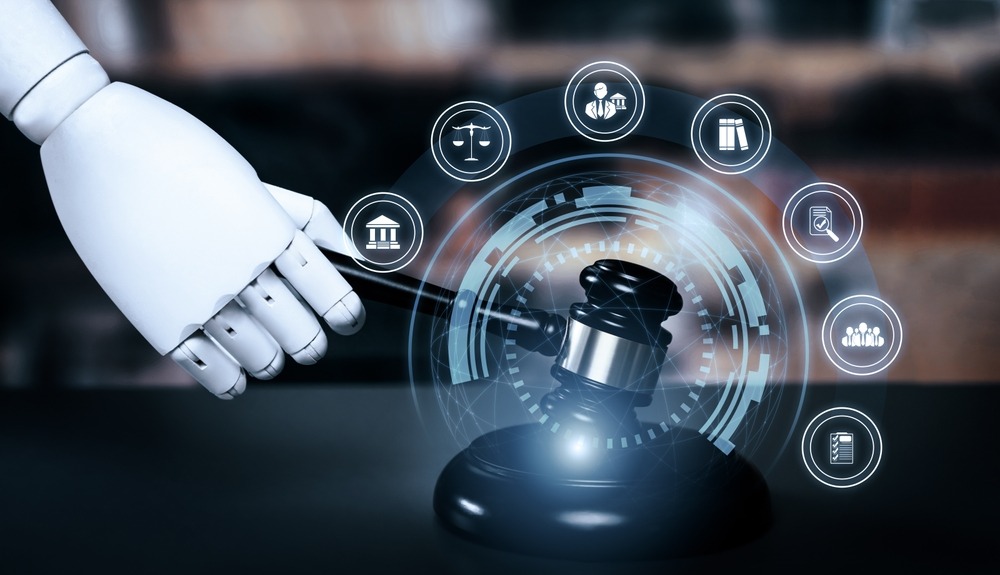AI Predictions for the Legal Industry in 2024

2024 is slated to be the Year of Artificial Intelligence, and the legal industry won’t be left behind. If your firm hasn’t dipped its toes into the AI tools pool yet, get ready to familiarize yourself with how to leverage AI to benefit your practice. It’s a fast-moving race to the top for developers and legal practices looking to channel AI in practical tool sets that can offer innovation and streamline legal processes, procedures, and support.
Getting started can be overwhelming, so let’s break down the major trends and how you can apply them to your firm.
AI in the Legal Industry
What separates AI from other technology solutions is the ability to learn intelligently and refine work output based on an individual’s creative input and feedback—a true continuous improvement model. But in what ways will AI improve a firm’s day-to-day operations?
Use cases of AI in the legal industry is growing, and includes:
- Technology-assisted review (TAR) of documents for discoverable or relevant information1
- Legal research within case law and statutes
- The use of predictive data analytics to identify insights, trends, and outcome likelihood
- Contract and legal document analysis
AI and generative AI (GenAI, or the use of AI to create new content) can also assist with your administrative workflow through:
- Drafting, proofreading, and identifying errors, inconsistencies, and missing information
- Task automation
- Document management and organization including comment handling, version histories, multiple formats, and cross-referencing
Rather than a replacement for human work and oversight, AI has the promise to offer analytical intelligence, assist with some aspects of case preparation, and provide a useful additional lens to drive case strategy.
How AI Benefits the Legal Industry
There are two very clear objectives when it comes to adopting new technology and processes for any business: to save time, and to save money.
AI in law has the potential to do both, resulting in:
- Staff time rechanneled to more productive, high-level, and strategic tasks
- Earlier assessment of risk and return to steer strategy, investment, and case involvement
- Higher consistency of output, resulting in greater accuracy across AI’s assigned tasks
- Greater ability to compare data across jurisdictions in order to build effective arguments
- More time and confidence to invest in case strategy and client relations
AI tools require input to improve their functionality and grow their reasoning and expertise in meeting your demands.
The quality of your AI output—especially bespoke tools—may be affected by your stewardship of how the tools learn and grow.
AI Trends for 2024
Professionals at the intersection of law and technology are excited about what’s coming this year. Based on our own surveys and a round-up on Law.com of industry expert’s predictions, here’s what we see coming in 2024.2,3,4,5,6
Development Trends
What exactly is available and how new tools come to market may shift based on industry demand and response in 2024. According to Law.com, trends will include:
- Document review – As one of the highest-demand functions, developers will focus on refining tools to review documents with deeper legal understanding and at a faster speed to facilitate their use in litigation.
- Pattern identification – AI tools will be developed to find patterns within data that allow firms to 1) identify factors that influence case successes and losses, 2) clarify relationships and connections between people, places, and occurrences, and 3) predict the success of arguments and approaches based on jurisdiction.
- Specialization – We’ll see more specialized tools designed for specific practice types, domains, and use cases, both off-the-shelf and custom-built.
- Generative AI output – GenAI’s ability to create content supported by legal reasoning will develop beyond text into audio and video output useful for case preparation, negotiation, and trial exhibits.
- Intake and communication – AI’s use as a firm gatekeeper and point-of-contact will increase, with AI integration for prospect response and management as well as client self-service.
- LLMs – There will be a rise in the availability and use of affordable, external large language models (LLMs) or AI systems that are pre-trained via absorbing a vast amount of data and have the capability of recognizing and generating text. The best will incorporate the data analysis of high-quality non-public legal documents in addition to public records.
- AI for AI recognition – Tools will allow for recognition of AI-generated content and case preparation may incorporate that layer of authorship in assigning responsibility or interpreting intent.
- Measurability – As AI becomes standardized, providers and tools will be required to prove their ability to provide material, measurable improvement and a return on investment.
Industry Response and Adoption
The legal industry’s response to AI integration in 2024 will become essential rather than exploratory. After the hype of 2023, leaders can refine their understanding and wisely adopt a technology stack that integrates AI in practical and profitable ways.
Some specific predictions from Law.com include:
- A growing divide between early and late adopters – Firms that started experimenting with AI in 2023 may have a leg up in understanding how to vet and invest in AI that will enhance their bottom line and expand or deepen their services. Similar to older firms that were reluctant to invest in a website, social media, or digital advertising, those who ignore AI may start falling behind.
- Use by plaintiffs’ firms – With endless piles of documents to absorb and the critical need to analyze risk and return, plaintiffs’ firms may lead the pack to invest in and embrace AI.
- Use for mergers and acquisitions – AI may become a key part of M&A due diligence, and a target company’s AI development, data training, and usage may be critical to measuring risks and opportunities at multiple levels.
- Litigation related to AI use – There may be a growth in litigation about the use of AI in relation to regulatory investigations and proceedings, cybersecurity and data privacy, antitrust, intellectual property, and labor and employment.7
- Rulings – A rising body of rulings and regulations may grow to govern the ethical and competent use of AI for trial evidence, legal documentation, and wholly AI-powered systems.
- Data management – Efficient use of AI tools requires quality internal law firm data, so cleaning current data and establishing better data management practices may be prioritized.
- AI governance – According to Law.com, firms may need to develop and adopt solid governance programs to regulate and document their use of AI with an eye toward contract compliance, intellectual property, disclosures, and cybersecurity. This may entail risk identification, monitoring, and reduction steps, and understanding how their own AI usage could be on trial externally.
- Legal software integration – Established software used by the legal industry may integrate AI tools and functions, acting as an entry point for some middle-wave adopters.
- Budget challenge – Budgets may be stretched to invest in AI tools without a proven model of ROI and potential staff or external services balancing.
- Human touch – A trend that may occur side by side with AI integration is increased value on human interaction, personalized approaches to clients, and “written by a human” content in addition to GenAI content.
How to Vet AI Tools
As with any technology investment, you’ll need to compare and vet competing products and prioritize unique and overlapping solutions. In addition to budget, consider:
- Level of change management and the developer’s ability to support it8
- Availability of trial and demo options for hands-on vetting by team members9
- Onboarding and ongoing training
- Technical support
- Customization to your practice workflow, specialty, and staffing
- Measurability of performance and ROI
- Scalability
Clarity and Expectations
If something sounds too good to be, then you’ll have to investigate a bit further. While AI promises to be a massive jump forward in how technology can be leveraged to assist with a legal workload, it’s necessary to do your due diligence. Be wary of:
- Solutions and value propositions that can’t be clearly explained
- Messaging inconsistency between sales, marketing, and support materials or promises
- Tools that don’t have clear and reportable performance indicators
- Theoretical or vague deliverables or timelines
Legal Industry Expertise
When you’re vetting a provider or tool, find out where their legal data and knowledge comes from. Ask the following:
- What role do legal domain experts play in their development process?
- How practice-based and up-to-date are their consulting legal professionals?
- What data banks are they using to train their LLMs?
- How much insider knowledge do they have about your firm structure and specialty?
Your Partner in Leading-Edge Support Services
U.S. Legal Support is looking to the future as we discover how new technology developments can shape our partnerships with legal firms and professionals.
We lead the way in providing litigation support services to attorneys of all practice sizes and types. This includes remote, in-person, stenographic and digital reporting services plus a SOC 2 Type 2 and HIPAA compliant client portal for fast and secure orders and communications.
Whatever type of litigation support you need—court reporting, transcription, interpreting and translation, records retrieval and review, litigation consulting, trial graphics, and more —we can help.
Ready to learn more? Reach out today to connect with us on your legal support needs.
Sources:
- American Bar Association. 7 Ways artificial intelligence can benefit your law firm. https://www.americanbar.org/news/abanews/publications/youraba/2017/september-2017/7-ways-artificial-intelligence-can-benefit-your-law-firm/
- ALM Global’s Legaltech News. Legal Tech’s Predictions for Artificial Intelligence in 2024. https://www.law.com/legaltechnews/2024/01/08/legal-techs-predictions-for-artificial-intelligence-in-2024/
- ALM Global’s Legaltech News. Legal Tech’s Predictions for KM, Data Governance & AI Usage in 2024. https://www.law.com/legaltechnews/2024/01/16/legal-techs-predictions-for-km-data-governance-ai-usage-in-2024/
- U.S. Legal Support. Survey Results Predict Top Legal Technology Trends for 2024. https://www.uslegalsupport.com/blog/survey-results-predict-top-legal-technology-trends-for-2024/
- Renaissance Rachel. 12 Best AI Legal Tools of 2024. https://renaissancerachel.com/best-ai-legal-tools/
- Thomson Reuters. How will leveraging AI change the future of legal services? https://www.reuters.com/legal/legalindustry/how-will-leveraging-ai-change-future-legal-services-2023-08-23/
- ALM Global’s Legaltech News. AI Adoption Likely to Spark Surge in Corporate Litigation of All Stripes in 2024. https://www.law.com/corpcounsel/2024/01/17/ai-adoption-likely-to-spark-surge-in-corporate-litigation-of-all-stripes-in-2024/
- Wolters Kluwer. Four best practices for evaluating legal AI solutions. https://www.wolterskluwer.com/en/expert-insights/four-best-practices-for-evaluating-legal-ai-solutions
- ClickUp. 10 Legal AI Tools for Legal Practices and Professionals in 2024. https://clickup.com/blog/ai-tools-for-lawyers/

Editoral Policy
Content published on the U.S. Legal Support blog is reviewed by professionals in the legal and litigation support services field to help ensure accurate information. The information provided in this blog is for informational purposes only and should not be construed as legal advice for attorneys or clients.


